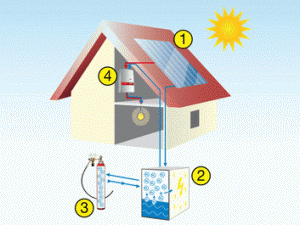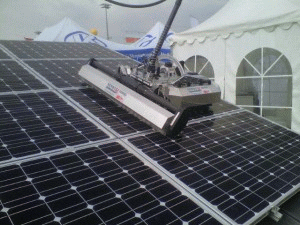Having just got back from Intersolar, Europe’s largest solar trade fair, I thought I’d give a round-up of some of my highlights from the show.
Thin film solar modules
I’m particularly interested in certain thin film modules that have now demonstrated their reliability and are starting to gain market acceptance. Some thin film PV companies have been around for over 20 years and many have fallen by the wayside. The surviving companies however are now looking very strong. Their products have now proven themselves in the lab and in the field, and the companies that make them have found ways to reduce production costs and improve efficiency. Thin film has inherently lower manufacturing cost than crystalline silicon, and the potential for efficiency improvement is greater. Therefore I’m confident that over time we will be seeing more thin film get installed.
Storage
A common theme of this years show is storage. Every inverter manufacturer had some kind of energy storage product on show this year. Most solar inverter manufacturers offer back-up energy storage systems that use batteries (typically Lead-acid or Lithium Ion). These provide day/night storage so that solar energy can be used after the sun has set in the evening. Batteries however are not great for storing energy over long periods, so they don’t solve the problem that more energy is produced in summer months than during the winter.
To deal with this problem, Fronius have unveiled their ‘Energy Cell,’ a hydrogen fuel storage system for the home. During the summer, an electrolyzer uses excess electricity from the PV system to split hydrogen from water and store it in a tank. During the winter, this hydrogen is then turned back into useful electricity via a fuel cell. The system has already been a prototype for several years, but this year’s Intersolar showed the system as being almost ready for the mass market. Of course the technology will start out very expensive, but it shows that solar energy can deliver constant power, and its only a matter of time before the cost of the technology falls.
How the Fronius energy cell works
Inverters
We spent some time with SolarEdge who have strengthened their product range and now offer a wider range of inverter sizes, all fully accredited for the UK. They have also been developing their system to be used on larger installations, so people may use them on commercial jobs as well from now in. They also launched a new solar ‘tetris’ game for Xbox Kinect – has to be seen to be believed!
Racking
Hilti have just launched their new flat roof mounting system and it looks amazing. It will make flat roof installations much more secure and manageable, and mean much lower risk of damaging the laminate. Also cool is this robot, used for cleaning solar panels on large arrays. It has 20 moveable sucker pads on the bottom that allow it to hop around cleaning the panels without falling off!
Solar panels cleaning robot


